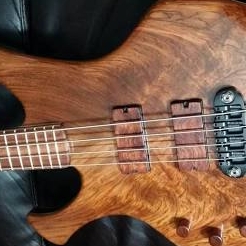I've been using delay units since I first started playing guitar (I tried playing through Pink Floyd's The Wall and found it to be necessity). I'm constantly looking for new ideas, and I have come across a few you might want to try.
I wanted to play Pachelbel's Canon in D, but couldn't figure out how to play it all live. I set the delay time to 8 seconds, and used my watch as a metronome to play at 120bpm. I started like this:
All notes equal half notes (1 second) E |-----------------|-2-0-------------|----------------- B |-----------------|-----3-2-0---0-2-|-3-2-0----------- G |-----------------|-----------2-----|-------2-0---0-2- D |-0---------------|-----------------|-----------4----- A |---0-2---------0-|-----------------|----------------- E |-------2-3---3---|-----------------|----------------- B |-----------3-----|-----------------|-----------------
[For this part, I used a seven-string guitar. To play the example on a 6-string use one of these two methods.
The first one sounds better, but for people like me who use locking tremelos, the second way is more convenient.]
I then started playing the melodies, and letting them overlap to create the canon (round) effect. It went over well when I played it at a banquet, and everyone kept asking me how I did it.
The next one is simple but I only discovered it a few months ago. To double your delay time, run the output into another delay. See? Simple, but it took me forever to figure it out.
Here's a neat one I came up with using my Digitech GSP-2101 and RP1 together. First there is a clean tone, then two and a half seconds later a distorted echo, then 2.5 seconds later a clean echo a perfect fifth higher, then 2.5 seconds again and a distorted echo a perfect fifth up.
The GSP-2101 is set like this: main input is sent through a 5 second delay. Delay output is sent to a pitch shifter set to +7. Original signal and pitch shifter output are sent to the right output. Original signal, pitch shifter output, AND right stereo return are sent to left output. The left output is sent to a guitar amp. The right output is sent to the RP1 input. The GSP-2101 distortion is left off.
The RP1 is set like this: main input is distorted and set to a 2.5 second delay. The delay output is sent to the left output. The original signal is NOT used. The left output is sent to the GSP-2101's right stereo effects return. Pretty neat, huh?
You might be interested in listening to Dream Theater's Lifting Shadows Off A Dream, from the album Awake. The guitarist is playing eighth notes that are echoed about three sixteenth notes later creating a sixteenth note rhythm.
If he played:
-------2---4---5---9------
You would hear:
-------2---4-2-5-4-9-5---9
Here are some more miscellaneous delay tricks:
Set the delay to quarter notes and play a scale in 8th notes for a Brian May style 3rd's effect.
Set a long delay time with infinite echoes, layer some rhythm tracks, then bypass the unit and solo over yourself (you can even slap the strings over the pickups for percussive sounds).
Sync the delay with a tremolo effect so when the guitar signal fades out the delay signal fades in. And for a cooler effect, run the delayed signal through a pitch shifter.
If you need help when attempting to set your digital delay to the proper number of milliseconds to match the tempo of the music you're playing, try using Guitar Nine's Delay Time Calculator.
Kevin Hammer is a guitarist from Savannah, TN who subscribes to the Frank Zappa credo, "Shut up and play yer guitar..."
He believes that there is room in the music business for everyone and any kind of music.
Kevin is a music major at the University of North Alabama, and is taking lessons in jazz and classical guitar.
